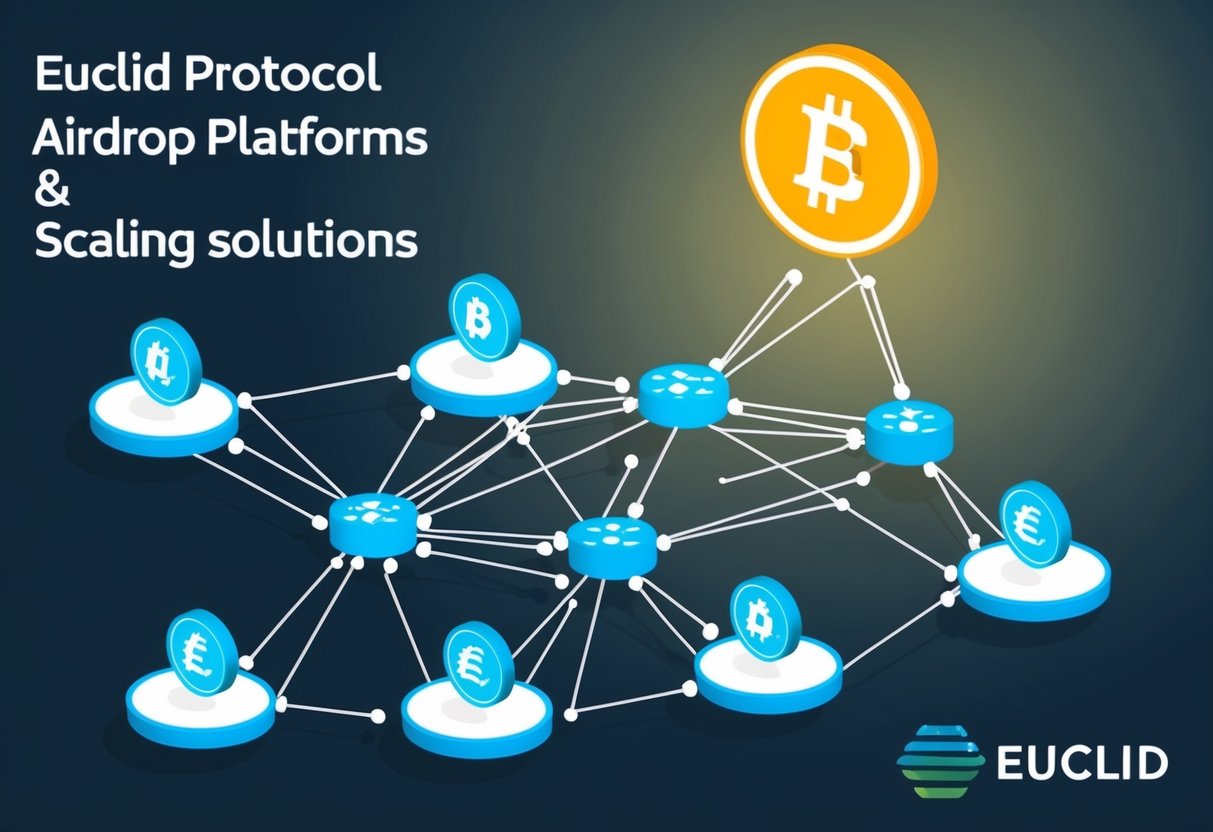
The Euclid Protocol Airdrop is an opportunity for users to earn rewards by joining the Euclid Protocol testnet and participating in activities like swapping and adding liquidity. This event is open to anyone who wants to explore new blockchain technology and potentially receive tokens for their efforts.

The testnet is simple to join, and there is no need to spend any money to qualify. By completing missions and using the features on the platform, users can increase their chances of receiving the airdrop when it occurs.
Interest in the Euclid Protocol airdrop is growing as more people look for ways to get involved in new crypto projects early. The rewards can be valuable, and the steps to participate are straightforward, attracting both new and experienced blockchain users.
Today’s Airdrop Checker Even: Step-by-Step Claim:
🌐 Step 1: Visit the Official Airdrop Reward Page.
Dive into the action by heading to the official airdrop page, where all live events are waiting for you. Log into your account by connecting your wallet from any MOBILE DEVICE.
📱 Step 2: Use Your Mobile Wallet
Eligibility checks are mobile-exclusive! Grab your smartphone and ensure you’re using a mobile wallet to participate.
💎 Step 3: Meet The Eligibility Criteria
Make sure your wallet isn’t empty or brand new—only active wallets qualify. If one doesn’t work, don’t worry! Try again with another wallet to secure your rewards. You can claim many rewards from multiple wallets, so try to use multiple wallets to increase your chance to claim.
💰 Step 4: Withdraw The Tokens
After signing the approval from your wallet, wait 5 to 10 minutes, and then congratulations! You will see a token claim in your wallet. You can easily exchange your tokens from SushiSwap, PancakeSwap, and many more.
Overview of the Euclid Protocol Airdrop

Euclid Protocol is hosting an airdrop focused on rewarding early users and testers. The airdrop process is connected to blockchain features and could bring benefits to those active in DeFi and Layer 2 ecosystems.
Purpose of the Airdrop
The goal of the Euclid Protocol airdrop is to grow its community and promote activity on its testnet. By giving away free $EUCLID tokens, the project encourages users to try out new DeFi features like swaps and liquidity pools. This can help prove the protocol’s usefulness and reliability before a larger launch or token generation event (TGE).
Participants also help by testing networks and providing feedback. This improves security and performance, helping the developers find and fix bugs. The airdrop rewards users for their time and support, making it a win-win for the project and the community.
The airdrop is also a way for Euclid Protocol to highlight its role as a modular liquidity layer. By making it easy for people from different blockchain backgrounds—such as Ethereum or other Layer 2 networks like Scroll—to join, it supports a more unified and accessible DeFi space.
Key Dates and Timeline
The Euclid Protocol airdrop is linked to the launch and testing of its platform. The public testnet went live in early 2025. Eligible participants can start using platform features, such as token swaps and liquidity adding, to qualify for rewards.
Airdrop details, including exact distribution dates and snapshot times, are usually announced through official channels like X (formerly Twitter) and the project website. The airdrop snapshot, which decides who is eligible, typically occurs near the end of the testnet phase.
After the snapshot, there is a period for data checks and reward calculations. Distribution of free $EUCLID tokens usually happens close to the Token Generation Event (TGE). Users should monitor news and social channels for updates, as timelines may shift with project changes.
Supported Blockchains
Euclid Protocol is built to provide liquidity across multiple blockchain networks. The testnet supports more than 20 chains, making it accessible to a large range of users. Its main focus is on the Ethereum ecosystem, including popular Layer 2 solutions.
Scroll—a Layer 2 network on Ethereum—plays a key part by offering lower fees and fast transactions. Users can interact with the protocol on both Ethereum mainnet and Scroll’s testnet. In addition, other EVM-compatible chains are supported, ensuring broad participation and easy access.
The airdrop does not include Bitcoin or Solana support at this time, focusing instead on EVM-based platforms. This makes it most relevant for users already active in DeFi on Ethereum, Scroll, and similar chains. Participating chains may expand as the project grows.
Eligibility and Participation Requirements

Taking part in the Euclid Protocol airdrop involves meeting certain requirements. Users should be careful to follow the rules set by the project to ensure eligibility and protect their security.
Qualifying Criteria
To qualify for the Euclid Protocol airdrop, participants usually need to complete a set of specific tasks. These tasks can include joining official social channels, following project updates, and interacting with the protocol’s products or services.
In most cases, users are asked to accumulate “ePoints” by finishing different activities. Such activities may include staking tokens, using decentralized finance (DeFi) tools, or providing liquidity to Euclid’s storage or financing solutions.
Eligibility might also depend on wallet activity and transaction history. Sometimes, there are restrictions based on region or previous engagement with the project, ensuring the process remains fair and decentralized. Participants must check if their account meets the minimum requirements listed on the official platform or announcements.
How to Register
Registration for the Euclid Protocol airdrop usually happens through the project’s official website or a trusted airdrop platform. First, users should connect their compatible crypto wallet, such as MetaMask or Trust Wallet. The system will often require participants to enter their wallet address and complete profile information.
Once the account is connected, users must follow clear step-by-step instructions. These may include filling out a registration form, agreeing to terms and conditions, and joining Euclid’s official Telegram, Discord, or Twitter.
Some platforms also provide a checklist of all actions needed to join. It is helpful to double-check all tasks for completion, use only official links, and avoid sharing sensitive information outside the official website. Regular updates and status checks are recommended to avoid missing deadlines or changes in eligibility.
Verification and Security Measures
Verification is a key part of the airdrop experience. Most airdrops require wallet verification to prevent fraud. This can mean signing a simple message with the user’s wallet to prove ownership, or—less often—completing a short KYC (Know Your Customer) process if required by law.
Security is closely watched throughout the process. The Euclid Protocol advises users not to share private keys and to verify that every step occurs only on official channels. Enhanced security steps, like two-factor authentication, may be encouraged, especially if personal details are needed.
To keep decentralization and protection standards high, the project enforces rules to avoid fake accounts and bots. Users should stay alert for phishing attempts and only interact with the official Euclid Protocol storage and financing tools when claiming their rewards.
Distribution Mechanism and Scaling Solutions

Euclid Protocol is improving how users access rewards and interact with DeFi by focusing on a fair token allocation, high transaction throughput, and decentralized data management. Their approach aims to keep transaction fees low while maintaining network speed and efficiency.
Token Allocation Model
Euclid Protocol uses an airdrop distribution for its $EUCLID tokens. Users who interact with the testnet, provide liquidity, or make swaps on supported networks may become eligible for rewards. The project divides tokens between early testers, liquidity providers, community members, and development teams.
A table of likely token distribution could look as follows:
| Category | Percentage (%) |
|---|---|
| Community/Airdrop | 50 |
| Liquidity Providers | 20 |
| Team/Developers | 20 |
| Ecosystem Incentives | 10 |
The model is designed to support both new users and active community participants. It encourages engagement, helping bootstrap liquidity and network growth early.
Transaction Speed and Performance
With the “Euclid” upgrade on the Scroll Layer 2, the protocol can now support much higher transactions per second (TPS). Transaction fees are reduced by around 90%, making it much cheaper and faster to move assets or trade.
Higher network throughput means more users can participate in DeFi activities like swapping or providing liquidity without facing delays. This approach helps avoid network congestion, a common problem in traditional blockchains, especially during peak activity.
The improved speed and lower costs make the airdrop and related activities much more accessible.
Decentralized Storage Integration
Euclid Protocol integrates decentralized storage to secure user and transaction data. By using decentralized storage rather than a single server, user information can be saved across many locations. This makes the system more secure against loss or attack.
This storage method supports the DeFi focus of the protocol. Data from swaps, liquidity pools, and rewards are kept available and tamper-proof. The integration of decentralized storage also allows for better transparency, since anyone can verify activity history if they need to.
Distributed data helps the protocol remain robust as it scales to support more users in the future.
Community Resources and Ongoing Updates
There are many ways users can find helpful information and stay updated about the Euclid Protocol Airdrop. Access to educational content and reliable news sources is key for getting the most out of the airdrop and understanding its role in the broader DeFi space.
Educational Materials and Videos
Euclid Protocol provides a range of educational materials to help new and experienced users. Many of these resources include guides on how to participate in the airdrop, use the testnet, and interact with their multi-chain swap features.
Video tutorials are especially useful. They break down each step in simple terms and often include screen recordings so viewers can follow along in real time. Official YouTube channels, Twitter/X Spaces, and community-run Discord servers often host Q&A sessions, AMAs, and walk-throughs of the protocol.
For those interested in AI and DeFi, there are deeper dives showing how Euclid Protocol leverages advanced tech to offer cross-chain liquidity and more seamless swaps. Tables and infographics are also shared in these spaces to explain key data points and FAQ.
Staying Informed About Future Airdrops
Staying up to date with new developments is critical for anyone hoping to claim future rewards. The main sources for updates are Euclid Protocol’s official social media channels, like Twitter/X, Discord, and Telegram.
Airdrop dashboards and websites such as CryptoRank regularly list upcoming reward opportunities, recent changes, and activity requirements. Users can set up alerts or subscribe to newsletters for real-time notifications.
Project blogs, Web3 community forums, and even livestream events announce changes in eligibility or extra steps needed for the next round of airdrops. Direct official announcements are the most reliable, so checking these channels regularly is strongly advised for those active in the DeFi, AI, and crypto reward scene.
Frequently Asked Questions
Euclid Protocol is running an airdrop through its testnet program. Participation involves wallet setup, completing on-chain actions, and paying attention to specific eligibility rules and timelines.
How can I participate in the Elys Network airdrop?
To take part in the Elys Network airdrop, users often need to connect their crypto wallet, interact with the platform, and complete any listed on-chain tasks. Details and instructions are usually found on the project’s official website or their social media channels.
What are the requirements to claim an airdrop from Euclid Protocol?
A connected, active crypto wallet is needed. Users must interact with the Euclid Protocol, such as by doing swaps and adding liquidity on test networks. Usually, some tasks or missions must be completed to become eligible for rewards.
Are there any key dates to be aware of for the Euclid Protocol airdrop?
Official dates for airdrop claim periods, eligibility deadlines, or reward distributions are announced by the project team. Following their X (Twitter) account or joining their community can help users stay informed about important dates.
What steps must be taken to successfully claim the Euclid Protocol airdrop?
Participants must set up a crypto wallet, access the testnet, and carry out activities like swapping tokens or providing liquidity. After completing these actions, they wait for official claim instructions from the protocol.
Is there a limited number of participants for the Euclid Protocol airdrop?
Some airdrops cap the number of eligible users or limit rewards based on certain milestones. Up-to-date details about participant caps or phases are shared by the protocol on their official channels.
Can I join the Euclid Protocol airdrop if I’m new to cryptocurrency?
New users can join as long as they create a compatible crypto wallet and follow simple instructions. No advanced knowledge is required, but it is important to follow the official steps to make sure tasks are done correctly.
Leave a Reply